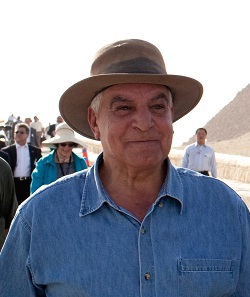by Annika Backe
translated by Teresa Teklic
January 19, 2017 – The news that the Egyptian pound has been devalued by 48 % caused worldwide consternation. Unpegging the pound from the dollar also did not prove beneficial for the local economy. To lift the somber mood, the printing press Secure Print Net has launched a design competition on Facebook. Accompanied by the hashtag “Egyptian currency design challenge” graphic designers and illustrators across the country are invited to submit proposals for a new banknote design.
Bust of Nefertiti. Neues Museum, Staatliche Museen zu Berlin. Photo: Magnus Manske / Wikimedia Commons / CC BY-SA 3.0.
Motifs
The most common motifs for the notes, whose nominal value extends from 25 piasters to 200 pounds, on Facebook posts are art-historical highlights of ancient Egypt, especially the world-famous Nefertiti. That is remarkable in so far as this particular artwork has not been stored in Egypt for more than 100 years now. It was found in 1912 during excavations in Amarna in Upper Egypt, financed by Berlin-based patron James Simon. That is why the bust – apparently a sculpture model – travelled to Germany after the partage. After several interim stations it has been on exhibition in the Neue Museum on the Berlin Museum Island again since 2009.
Zahi Hawass in 2009. Photo: The White House Stream / Wikipedia.
Why Nefertiti?
Why do many Egyptians choose Nefertiti as a symbol of national identity and not one of the great artworks located in the museums of their country? Many signs indicate that this can be “credited” to Zahi Hawass. Hawass, who holds a PhD in Archaeology and Egyptology, was forced to resign from his office as Minister of Antiquities in 2011. Too serious were the accusations laid against him, which ranged from granting competitive advantages to involvement in illegal trading with Egyptian cultural objects. Although he was fined and sentenced to jail time and forced labor, he was reinstated in office not much later. And he marketed this effectively in the media, using every single opportunity to insist on the return of Nefertiti to Egypt, whose export to Germany, he claimed, had been illegal.
Hawass, divested of his office again in 2011, cared little that this was entirely legal within the framework of partage of archaeological excavations. He who boasts of having breathed new life into Egypt’s old and dusty museums on his website apparently finds a large audience among young creatives. He has succeeded in making individual national treasures more widely known than their historical background.
To view the Facebook page with the new banknote designs, click here.
This is the website of the Neues Museum Berlin.
You can look at the official design of the Egyptian banknotes here.
To access the website of the James Simon Foundation click here (German only).
A number of articles on Zahi Hawass have already been published in CoinsWeekly.
For Zahi Hawass’ website click here.
Hawass can also be found on Wikipedia.
Illuminating insights into the management of Egyptian antiquities provides this book by Waafa El Saddik, reviewed for you here.





